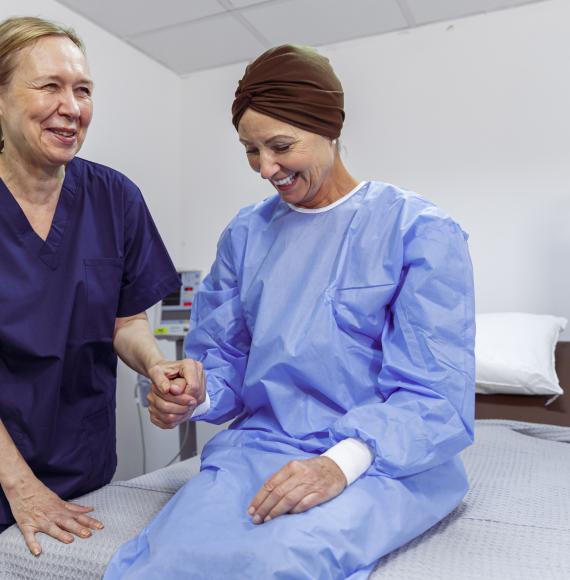Here’s a question.
What does the NHS have in common with a frisbee?
The answer is “not much”, but perhaps slightly more than you’d imagine.
They’re the same age – invented in 1948 – and have fundamentally remained the same ever since.
The differences, of course, are easier to spot. A frisbee moves far and fast by design. Assuming the laws of physics remain unchanged, a frisbee will always work, though you can tinker round the edges with the shape of the disk and so on. Meanwhile, the NHS was designed in an era, for that era. Unlike the laws of physics, the social, political, and environmental landscape in which we live has changed radically since the 1940s.
Despite this, the NHS has worn remarkably well. But there’s no denying that if designed from scratch today, it would look different. Rather than focusing on reactive care – making sick people better - it would emphasise prevention. Patients, clinicians and politicians are all aligned on that principle, but how this is done, and by whom, is trickier. Our current system has largely evolved organically. The landscape looks different in different areas with the result that money, staff and patients fall between the cracks, especially when moving between services or geographies.
A considerable amount of thought and effort has gone into addressing this at a clinical level, which is very welcome. For example, cancer patients now have a clear pathway from their initial referral from primary care, through to secondary and tertiary care, and – where appropriate – on to voluntary sector services such as hospices.
And the introduction of new Integrated Care Systems (ICSs) is centred on meeting the health and care needs across an area – coordinating services and planning in a way that improves population health and reduces inequalities.
But whilst clinical pathways have become clearer, the same isn’t always true of the back office. At the risk of stating the obvious – effective care requires an efficient and effective back office. Things like paying staff accurately. Recruiting the right people. Ensuring the correct products are in the correct place at the correct time. Paying suppliers. If any of these fail, we fail the patient.
And it’s here that the cracks I mention above can become gaping chasms. With multiple different corporate systems across multiple health and care organisations, comes a lack of integration and common standards.
Even NHS organisations have different corporate systems. When you add in local authorities, Community Interest Companies and the voluntary sector, the lack of consistency becomes serious – even existential.
So I don’t think anyone was surprised when NHS England and NHS Improvement (NHSEI) recently published guidance that directs systems towards corporate services transformation, via consolidation and collaboration, to improve services and achieve savings.
The national guidance says ICSs “should carry out a diagnostic exercise to establish the scale of opportunity” from implementing enhanced procurement practices; “ensure interoperability, standardisation and optimisation of automation” across financial services; and review payroll arrangements “to ensure service quality and value for money” and “system collaboration at a minimum”.
This isn’t a particularly new idea. Many attempts have been made to address efficiencies, from new IT platforms to adopting common procurement processes. The problem for the diverse range of organisations coming together to work as one system, of course, is identifying what’s already working well, and what needs improvement. Or to put it another way – making sure that knowledge and good practice is shared widely. Thankfully, this is an area on which my organisation – NHS Shared Business Services – can shed light.
For since 2014 we have partnered with NHS organisations right across the country to baseline processes against industry best practice, assess maturity against relevant benchmarks and standards, identify opportunities for improvements and efficiencies, and ensure compliance with national requirements.
We’ve now taken this one step further and developed a bespoke Insight Diagnostic solution for ICSs, enabling them to benchmark finance and procurement practices (as above) at each member organisation.
By taking an agnostic and independent view, it’s possible to co-create a holistic, joined-up source to settle roadmap for organisations to drive collaboration and best value across regional systems. To ensure maximum effectiveness, these roadmaps need to be driven by data and benchmarked against relevant best-practice and industry standards - with agreed recommendations for short- medium- and long-term efficiency, productivity, compliance and cost-saving gains.
By combining human ingenuity with data on a massive scale, it’s possible to identify what’s working well; where there are areas of inconsistency within and across ICSs; and where the greatest improvement opportunities lie. Doing this not only helps ICSs to accelerate collaboration and exploit efficiencies – it unlocks the power of NHS staff to deliver them.
And, whilst health and social care may never quite be comparable with a frisbee, a foundation of iterative improvements through data and collaboration at least provides some design principles for a system which doesn’t need redrawing every time it needs to move far and fast.



















